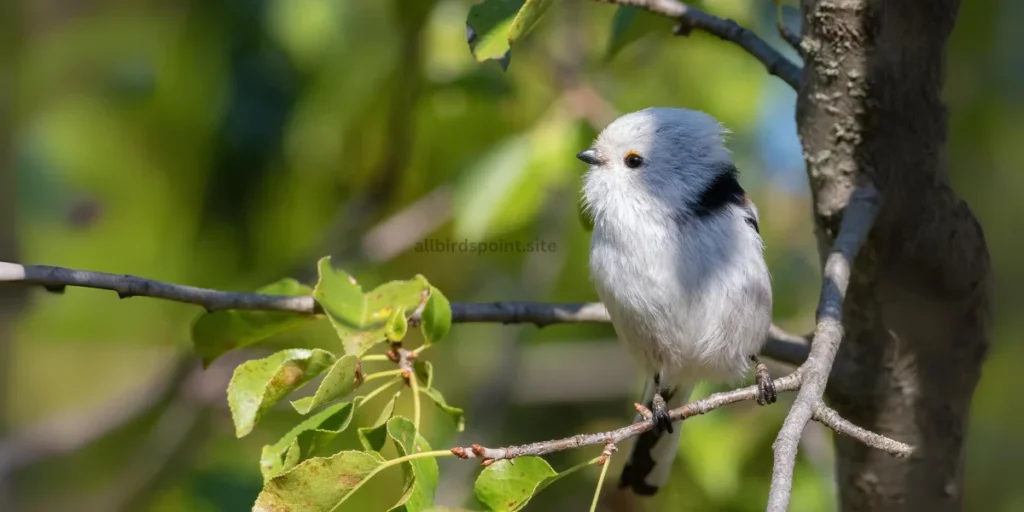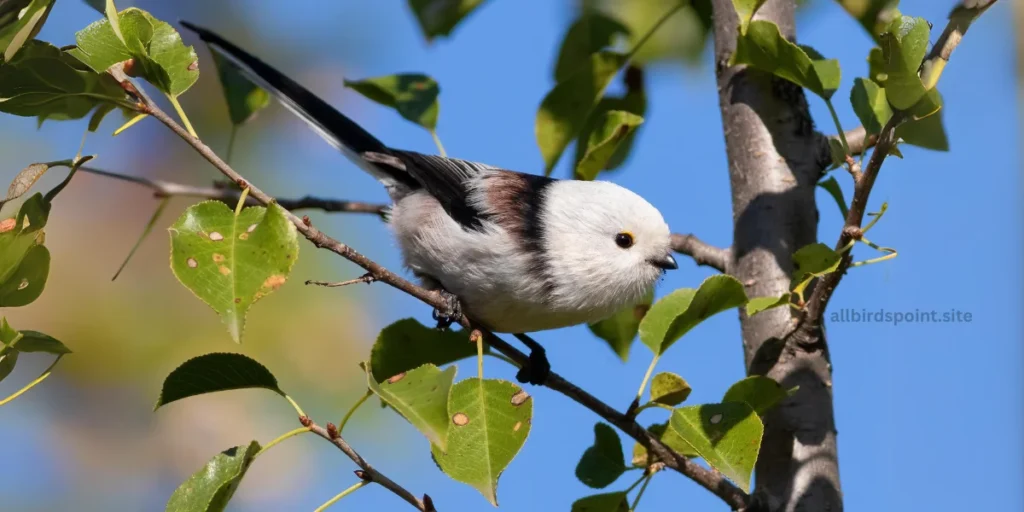The Shima Enaga is a small, fluffy bird found in Hokkaido, Japan. It is also known as the “long-tailed tit.” This bird is very cute because of its round body and white face. Shima Enaga birds are active and often seen in groups, flying from tree to tree looking for food like insects and seeds. They are small, quick, and have long tails. People in Japan love this bird because of its adorable appearance and playful nature.
Shima Enaga: The Adorable Bird of Japan
Introduction
The Shima Enaga is a tiny, fluffy bird that lives in Japan, specifically in Hokkaido, the northern part of the country. It is a unique type of long-tailed tit with a round body, long tail, and a pure white face. Its cute appearance and playful nature have made it a favorite among bird lovers and photographers. This article will explore every aspect of the Shima Enaga in easy words: its physical features, lifestyle, habits, nesting, cultural significance, and much more. Let’s dive into the life of this little bird that has captured the hearts of many.

The Basics: What Is the Shima Enaga?
Physical Appearance
The Shima Enaga is a very small bird, often described as looking like a “ball of fluff” with a long tail. It measures around 13 to 15 cm in length, but half of this length is the tail alone. The bird’s face is pure white, giving it a clean, cotton-like look. The rest of its body is covered with light brown, black, and gray feathers. The long tail makes the bird look elegant, but its round shape and tiny size add to its adorable appearance.
| Feature | Description |
|---|---|
| Length | 13-15 cm (with tail) |
| Weight | Around 7-9 grams |
| Face Color | Pure white |
| Body Color | Mix of gray, brown, and black |
| Tail | Long and thin |
Where Can You Find It?
The Shima Enaga is mostly found in the forests of Hokkaido, Japan’s northernmost island. They prefer cold, forested areas where they can easily find food and build their nests. Although the Shima Enaga belongs to the long-tailed tit family, it is unique in its appearance. Other long-tailed tits in Japan have a mix of colors on their faces, but the Shima Enaga’s face is completely white, making it stand out.
The Life and Behavior of Shima Enaga
Daily Activities
The Shima Enaga is very active and playful. It spends most of its day flying from tree to tree, hopping on branches, and looking for food. They are not strong fliers, but they are quick, moving in short bursts. Because of their friendly nature, they usually travel in small flocks, especially during the colder months. Watching them play in groups is a delightful sight.
What Do They Eat?
Shima Enagas are insectivores, which means they mainly eat insects. They also enjoy small spiders and seeds. The bird uses its quick movements to search for food on branches, leaves, and tree bark. Since they stay in groups, they often help each other find food and can be seen sharing their meals.
| Food Type | Examples |
|---|---|
| Insects | Small bugs, caterpillars, flies |
| Spiders | Small spiders found on trees |
| Seeds | Tree seeds, plant seeds |
Nesting and Raising Young
How They Build Their Nests
The Shima Enaga is an expert nest builder. They create nests that look like small pouches hanging from branches. These nests are built using moss, feathers, plant fibers, and spider webs. The nests are carefully hidden among tree branches to protect the eggs from predators and harsh weather. It takes around 20 days to build a nest, and once finished, it provides a warm and secure space for the eggs. The opening of the nest is small and located at the top, making it easy for the bird to enter but hard for predators.
Family Life and Raising Chicks
Shima Enagas lay about 5 to 9 eggs during the breeding season. The eggs are tiny and white. The mother bird spends most of her time warming the eggs, while the father bird goes out to find food. Once the chicks hatch, both parents take care of feeding them. The chicks grow quickly, and after about two weeks, they leave the nest. Even after they leave the nest, the young birds stay close to their parents to learn how to find food and survive on their own.

Surviving the Harsh Winters of Hokkaido
Adapting to the Cold
Hokkaido is known for its cold winters, and the Shima Enaga has adapted well to survive in such conditions. Their thick feathers provide warmth, and their round bodies help conserve heat. Additionally, these birds stay together in flocks during winter, which helps them share body heat and stay warm. The colder the weather, the closer the birds stick together.
Finding Food in Winter
Winter can be a challenging time for Shima Enagas to find food. Most of their food sources, like insects, are not easily available during the colder months. However, the birds have learned to find small insects hidden under tree bark and leaves. They also eat seeds and small fruits when insects are not available. By staying active and always on the move, Shima Enagas keep their bodies warm and find enough food to survive.
Shima Enaga in Japanese Culture
A Symbol of Cuteness
In Japan, the idea of “kawaii,” which means “cute,” is an important part of the culture. The Shima Enaga fits perfectly into this concept with its fluffy round body and playful nature. Because of its cute appearance, the bird has become a popular character in art, toys, and various products. People enjoy watching the bird because it brings joy and a sense of happiness.
Art, Merchandise, and Popularity
The Shima Enaga is so loved that its image appears on many items, including stationery, toys, and accessories. Artists often draw or paint pictures of the bird, and you can find these artworks on postcards, posters, and even T-shirts. Photographers also love capturing images of the bird, especially during winter when the Shima Enaga looks like a little puffball against the snow.
| Type of Merchandise | Examples |
|---|---|
| Art | Postcards, prints, paintings |
| Toys | Stuffed animals, keychains |
| Accessories | Phone cases, bags, pins |
| Home Items | Mugs, plates, notebooks |
Conservation and Protection of Shima Enaga
Current Status and Threats
The Shima Enaga is not currently at risk of extinction. However, like many other birds, it faces some challenges, such as habitat loss and environmental changes. As urban areas grow, the natural forests that the Shima Enaga depends on become smaller. It is important to protect these forested areas so that the bird has enough space to live, find food, and raise its young.
How to Help Protect the Shima Enaga
People who love the Shima Enaga can help protect it by supporting conservation efforts in Hokkaido. This means creating protected natural areas, reducing deforestation, and ensuring that the bird has a healthy environment. Even small actions, like creating bird-friendly gardens or reducing the use of chemicals that harm wildlife, can make a big difference. Supporting organizations that focus on wildlife protection can also help ensure the Shima Enaga continues to thrive.
Fascinating Facts About the Shima Enaga
- Tiny but Tough: Even though the Shima Enaga is small and looks delicate, it is quite tough and can survive the cold winters of Hokkaido.
- Social Creatures: These birds love to stay in groups, which helps them stay warm, find food, and protect themselves from danger.
- Master Builders: The nests built by Shima Enagas are well-designed and cozy, keeping their eggs safe from predators and bad weather.
- Unique Among Tits: While the Shima Enaga belongs to the long-tailed tit family, its pure white face makes it stand out as a unique and special type.
- Easy to Spot in Winter: Because of their bright white faces, Shima Enagas are easy to spot against the snowy backgrounds of Hokkaido, making them a favorite for winter birdwatchers and photographers.

How the Shima Enaga Stays Healthy and Active
Staying Warm
The Shima Enaga’s thick feathers help keep it warm during the cold months. They also have a habit of fluffing up their feathers to trap heat, which makes them look even rounder and cuter. Staying in groups is another way the birds keep warm. By huddling together, they share body heat and protect each other from the cold wind.
Always on the Move
To find food and stay active, the Shima Enaga moves a lot. The bird’s constant movement helps it stay warm and find enough food to eat. They hop quickly from branch to branch, always looking for insects, spiders, and seeds. The quick and playful movements of the bird make it seem full of energy, even during the coldest days of winter.
The Joy of Birdwatching: Spotting a Shima Enaga
For bird lovers and nature photographers, spotting a Shima Enaga is a special experience. The best time to see these birds is in winter when their white faces are easy to see against the snowy trees of Hokkaido. Since they travel in groups, it’s common to see many of them at once, hopping around and playing together. If you plan to visit Hokkaido, bring a camera because capturing a photo of a Shima Enaga is like capturing a little moment of happiness.
Tips for Birdwatching
- Visit in Winter: The best time to see Shima Enagas is during the winter months when they are most active.
- Look in Forests and Parks: These birds like to stay in wooded areas, so visit forests, parks, or gardens in Hokkaido.
- Move Quietly: Since Shima Enagas are small and quick, try to move quietly to avoid scaring them away.
Conclusion
The Shima Enaga is a special little bird that has won the hearts of people all over Japan and beyond. Its fluffy appearance, playful behavior, and social nature make it a joy to watch. Living in the cold forests of Hokkaido, the Shima Enaga has adapted to survive harsh winters and find food even in difficult conditions. As a symbol of cuteness in Japanese culture, the bird has become a popular subject for art, toys, and everyday items.
By understanding more about the Shima Enaga, we can appreciate its beauty and importance in nature. Protecting this bird and its habitat is not just about saving one species but also about preserving the joy and wonder that the natural world brings to all of us. Whether you are a bird lover, a photographer, or someone who simply enjoys cute animals, the Shima Enaga is sure to bring a smile to your face and warm your heart.
FAQs
1. What is a Shima Enaga?
The Shima Enaga is a small, fluffy white-faced bird found in Hokkaido, Japan. It is a type of long-tailed tit.
2. Where can I find Shima Enaga?
You can find them in forests, parks, and gardens across Hokkaido, Japan, especially during the winter.
3. What does a Shima Enaga eat?
Shima Enagas eat insects, spiders, and seeds. They search for food on tree branches and bark.
4. Why is the Shima Enaga so popular?
Its pure white face, round body, and playful behavior make it a symbol of cuteness in Japan.
5. Is the Shima Enaga at risk of extinction?
No, the Shima Enaga is not currently at risk, but habitat protection is important for its survival.
6. When is the best time to see Shima Enaga?
Winter is the best time to spot them as they are more active and easier to see against the snow.
7. How big is the Shima Enaga?
They are around 13-15 cm long, with their tail making up half of their body length.

1 thought on “Shima Enaga: Japan’s Adorable White Bird – Facts & Pictures”